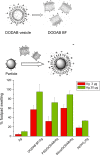Biomimetic nanoparticles: preparation, characterization and biomedical applications
- PMID: 20463941
- PMCID: PMC2865020
- DOI: 10.2147/ijn.s9035
Biomimetic nanoparticles: preparation, characterization and biomedical applications
Abstract
Mimicking nature is a powerful approach for developing novel lipid-based devices for drug and vaccine delivery. In this review, biomimetic assemblies based on natural or synthetic lipids by themselves or associated to silica, latex or drug particles will be discussed. In water, self-assembly of lipid molecules into supramolecular structures is fairly well understood. However, their self-assembly on a solid surface or at an interface remains poorly understood. In certain cases, hydrophobic drug granules can be dispersed in aqueous solution via lipid adsorption surrounding the drug particles as nanocapsules. In other instances, hydrophobic drug molecules attach as monomers to borders of lipid bilayer fragments providing drug formulations that are effective in vivo at low drug-to-lipid-molar ratio. Cationic biomimetic particles offer suitable interfacial environment for adsorption, presentation and targeting of biomolecules in vivo. Thereby antigens can effectively be presented by tailored biomimetic particles for development of vaccines over a range of defined and controllable particle sizes. Biomolecular recognition between receptor and ligand can be reconstituted by means of receptor immobilization into supported lipidic bilayers allowing isolation and characterization of signal transduction steps.
Keywords: antigens; bilayer fragments; cationic lipid; drugs; novel cationic immunoadjuvants; phospholipids; polymeric particles; silica; vesicles.
Figures





Similar articles
-
Biomimetic particles in drug and vaccine delivery.J Liposome Res. 2007;17(3-4):165-72. doi: 10.1080/08982100701525530. J Liposome Res. 2007. PMID: 18027236
-
Preparation and characterization of biomimetic nanoparticles for drug delivery.Methods Mol Biol. 2012;906:283-94. doi: 10.1007/978-1-61779-953-2_22. Methods Mol Biol. 2012. PMID: 22791441
-
Biomimetic Lipid Polymer Nanoparticles for Drug Delivery.Methods Mol Biol. 2020;2118:45-60. doi: 10.1007/978-1-0716-0319-2_4. Methods Mol Biol. 2020. PMID: 32152970
-
Nanomedicine for cancer: lipid-based nanostructures for drug delivery and monitoring.Acc Chem Res. 2011 Oct 18;44(10):1080-93. doi: 10.1021/ar200011r. Epub 2011 Jul 26. Acc Chem Res. 2011. PMID: 21786832 Review.
-
Hyperbranched polymer vesicles: from self-assembly, characterization, mechanisms, and properties to applications.Chem Soc Rev. 2015 Jun 21;44(12):3874-89. doi: 10.1039/c4cs00274a. Chem Soc Rev. 2015. PMID: 25336064 Review.
Cited by
-
De novo design of a nanoregulator for the dynamic restoration of ovarian tissue in cryopreservation and transplantation.J Nanobiotechnology. 2024 Jun 11;22(1):330. doi: 10.1186/s12951-024-02602-5. J Nanobiotechnology. 2024. PMID: 38862987 Free PMC article. Review.
-
Recent advances of natural and bioengineered extracellular vesicles and their application in vascular regeneration.Regen Biomater. 2022 Sep 5;9:rbac064. doi: 10.1093/rb/rbac064. eCollection 2022. Regen Biomater. 2022. PMID: 36176713 Free PMC article. Review.
-
Cationic Biomimetic Particles of Polystyrene/Cationic Bilayer/Gramicidin for Optimal Bactericidal Activity.Nanomaterials (Basel). 2017 Dec 2;7(12):422. doi: 10.3390/nano7120422. Nanomaterials (Basel). 2017. PMID: 29207496 Free PMC article.
-
Impact of poly(ethylene glycol) functionalized lipids on ordering and fluidity of colloid supported lipid bilayers.Soft Matter. 2022 Oct 12;18(39):7569-7578. doi: 10.1039/d2sm00806h. Soft Matter. 2022. PMID: 36165127 Free PMC article.
-
Virosome: An engineered virus for vaccine delivery.Saudi Pharm J. 2023 May;31(5):752-764. doi: 10.1016/j.jsps.2023.03.016. Epub 2023 Mar 31. Saudi Pharm J. 2023. PMID: 37181145 Free PMC article. Review.
References
-
- El-Sayed IH, Huang X, El-Sayed MA. Surface plasmon resonance scattering and absorption of anti-EGFR antibody conjugated gold nanoparticles in cancer diagnostics: applications in oral cancer. Nano Lett. 2005;5:829–834. - PubMed
-
- Medintz AR, Clapp JS, Melinger JR, Deschamps H, Mattoussi A. Reagentless Biosensing assembly based on quantum dot-donor Förster resonance energy transfer. Adv Mater. 2005;17:2450–2455.
-
- Carmona-Ribeiro AM. Bilayer-forming synthetic lipids: drugs or carriers? Curr Med Chem. 2003;10:2425–2446. - PubMed
-
- O’Hagan DT, Singh M, Ulmer JB. Microparticles for the delivery of DNA vaccines. Immunol Rev. 2004;199:191–200. - PubMed
-
- Caputo A, Sparnacci K, Ensoli B, Tondelli L. Functional Polymeric nano/microparticles for surface adsorption and delivery of protein and DNA vaccines. Curr Drug Delivery. 2008;5:230–242. - PubMed
Publication types
MeSH terms
Substances
LinkOut - more resources
Full Text Sources
Other Literature Sources

